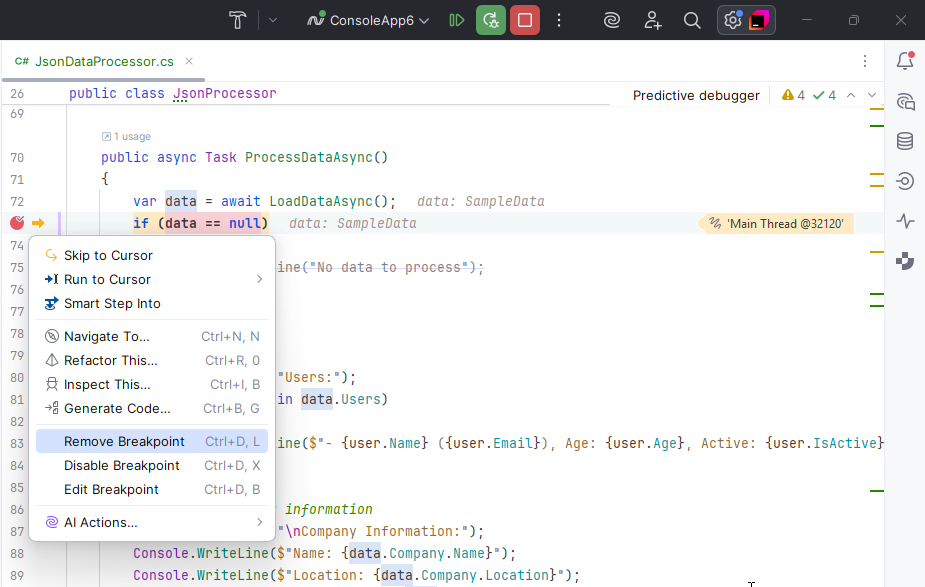Debugging
Debugger is an integral part of JetBrains Rider that allows you to examine the runtime behavior of your application, identify problematic code, and isolate the source of the problem step by step.
Typical debugging steps
Define a run/debug configuration for the program that you want to debug.
Set breakpoints in the source code where the potential problem may lie.
Start debugging by launching your program in the debug mode Shift+F9 or attaching to a running process Ctrl+Alt+F5.
When the program execution breaks, step through your code, inspect variables, and evaluate expressions.
You can edit the code of a suspended program and then continue debugging without restarting with Hot Reload.
Resume the debugging session F9 to let the program run to the next breakpoint, if any.
To finish the debugging session, press Ctrl+F2, select in the menu, or click Stop
in the Debug window.
The major part of debugging activities takes place in the Debug window, which becomes available once you start debugging. To open this window, press Alt+5 or select View | Tool Windows | Debug in the main menu.
While debugging, you can also perform the most common debugger actions from the Alt+Enter menu. For example Run to Cursor, Skip to Cursor or Toggle breakpoints:

You may be also interested in the following language- and framework-specific guidelines:
Shortcuts for debugging actions
Shift+F10 | |
Alt+Shift+F10 | |
Shift+F9 | |
Alt+Shift+F9 | |
Ctrl+Alt+F5 | |
Ctrl+Alt+Shift+F5 | |
Ctrl+F2 | |
Ctrl+D, P | |
F9 | |
Ctrl+O, A | |
Stop Background Processes... | Ctrl+Shift+F2 |
F8 | |
Alt+Shift+F8 | |
F7 | |
Shift+F7 | |
Alt+Shift+F7 | |
Shift+F8 | |
Alt+F9 | |
Ctrl+Alt+F9 | |
Ctrl+Alt+Shift+F9 | |
Alt+F10 | |
Alt+F8 | |
Ctrl+Alt+F8 | |
Ctrl+F8 | |
Ctrl+Alt+Shift+F8 | |
Ctrl+D, X | |
Ctrl+Shift+F8 | |
Ctrl+Shift+F8 | |
Alt+4 | |
Alt+5 | |
Alt+8 | |
Ctrl+I, S |
For the full list of JetBrains Rider keyboard shortcuts, refer to Keyboard shortcuts in predefined keymaps.